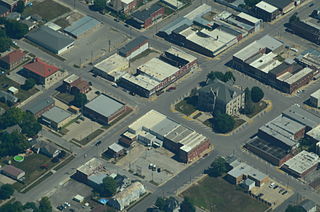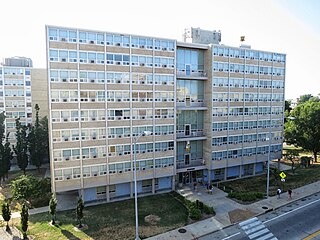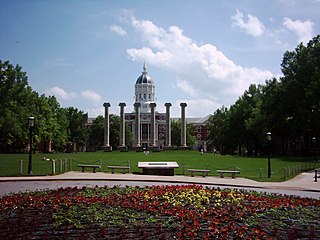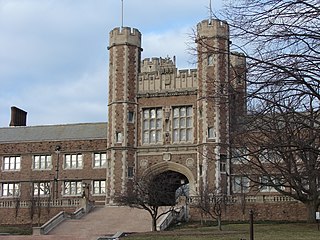
Carrollton is a city in Carroll County, Missouri, United States. Carrollton won the 2005 All-America City Award, given out annually by the National Civic League. The population was 3,784 at the 2010 census. The population is down 338 residents since 2000. Carrollton is the county seat of Carroll County.

Fayette is a city in Howard County, Missouri, United States. The population was 2,688 at the 2010 census. It is the county seat of Howard County. It is part of the Columbia, Missouri Metropolitan Statistical Area.

Sheldon Jackson College (SJC) was a small private college located on Baranof Island in Sitka, Alaska, United States. Founded in 1878, it was the oldest institution of higher learning in Alaska and maintained a historic relationship with the Presbyterian Church. The college was named in honor of Rev. Sheldon Jackson, an early missionary and educational leader in Alaska.
The Mizzou Botanic Garden contains thousands of plants within the campus of the University of Missouri in Columbia, Missouri, United States. The Garden includes famous icons, such as Thomas Jefferson's original grave marker and the Columns of Academic Hall, and is open year-round, only asking for a small donation to visit.

For other educational establishments with a similar name please see William Penn School

Laws Hall was a residence hall at the University of Missouri. Located at the corner of Tiger Avenue and Kentucky Boulevard, Laws comprised a gross area of 72,871 square feet (6,769.9 m2) over 9 floors and basement area. The street address was 1005 Tiger Ave. 65201. The structure was constructed in 1957 as a women's residence hall. Eventually made a co-education residence hall, Laws housed students until the end of the 2015-2016 academic year. The building was demolished in March 2017 as part the final phase of the university's residence halls master plan.

Jesse Hall is the main administration building for the University of Missouri. Its dome has towered 180 feet above the south end of David R. Francis Quadrangle since its completion in 1895. In the lawn in front of Jesse Hall are The Columns, all that remains of its predecessor Academic Hall, which burned in 1892. The building contains the office of the chancellor, university registrar, graduate school, admissions, and financial aid. One of the most photographic landmarks in Missouri, the building was designed by Missouri architect Morris Frederick Bell, and is his largest surviving work. Jesse Auditorium had hosted graduations and countless university functions over the years. The University Concert Series presents national and international concerts, Broadway shows, performers, bands, speakers, and theater to the largest auditorium in Columbia. As the former home of the School of Music, student performances occasionally happen. The building is the most prominent contributing structure to the David R. Francis Quadrangle National Register of Historic Places District. In 1922 "New Academic Hall" became "Jesse Hall" in honor of retiring University President Richard Henry Jesse.

David R. Francis Quadrangle is the historical center of the University of Missouri in Columbia, Missouri. Known as The Quad it is the oldest part of Red Campus and adjacent to Downtown Columbia at the south end of the Avenue of the Columns. At its center are six Ionic columns, all that remains of the original university building Academic Hall. Twelve buildings front the modern quadrangle including the domed main administration building Jesse Hall, the tallest building in Columbia. The Quad was designed and constructed by architect Morris Frederick Bell and his assistant William Lincoln Garver. It is named after Missouri governor David R. Francis. Eighteen structures, including the entire quad and most of Red Campus are listed as the Francis Quadrangle National Historic District. An obelisk, the original tombstone of Thomas Jefferson stands in front of the Chancellor's Residence. It was gifted to the University by Jefferson's descendants in recognition of Missouri's ties to Virginia. In front of Jesse Hall stand markers honoring university president Richard Henry Jesse and Missouri governor David R. Francis. Nearby is another obelisk in memory of Missouri's first U.S. senator David Barton, The Missouri School of Journalism is located at the northeast corner of The Quad, comprising Walter Williams Hall, Neff Hall, Gannet Hall, along with the Reynolds Journalism Institute. To the west, Switzler Hall is the oldest academic building on campus, though the Residence on the Quad, home of the chancellor, is the oldest building overall. The University of Missouri College of Engineering completes the west side. Pickard Hall is currently closed due to radiation contamination from turn of the century experiments. Swallow Hall was recently renovated and houses the Departments of Anthropology, Visual Studies and Ancient Mediterranean Studies.

Switzler Hall is an academic hall on the campus of the University of Missouri in Columbia, Missouri. The building was completed in 1872, and it is located on the west side of the David R. Francis Quadrangle. Switzler Hall is the oldest academic building and second oldest structure on campus after the Chancellor's Residence. The building was named after Colonel William Franklin Switzler, editor and publisher of the Missouri Statesman and supporter of the University. Today the building houses the Department of Communication, Women's and Gender Studies, and the Special Degrees Program. The building is listed on the National Register of Historic Places.

Academic Hall was the original main building of the University of Missouri. It was dedicated in 1843 and destroyed by fire in 1892. Academic Hall's six Ionic columns, today known as The Columns, stand on Francis Quadrangle as the most recognizable symbol of the University of Missouri.

Sanborn Field is an agricultural experiment field, located on the University of Missouri campus in Columbia, Missouri. Established in 1888, it was the first facility in the United States intended to measure erosion and run-off for differing crops and agricultural practices. Work at Sanborn Field was influential in the establishment of soil conservation policy in the United States. The field was designated a National Historic Landmark in 1964.

The Washington University Hilltop Campus Historic District was the site of the 1904 Louisiana Purchase Exposition and the 1904 Summer Olympics. Many of the exposition buildings were temporary in nature, but a number of permanent structures were built and are used by Washington University, which calls this area the Danforth Campus. The district includes more than fifty structures, of which twenty are in the Collegiate Gothic style.

Downtown Columbia is the central business, government, and social core of Columbia, Missouri and the Columbia Metropolitan Area. Three colleges — the University of Missouri, Stephens College, and Columbia College — all border the area. Downtown Columbia is an area of approximately one square mile surrounded by the University of Missouri on the south, Stephens College to the east, and Columbia College on the north. The area serves as Columbia's financial and business district and is the topic of a large initiative to draw tourism, which includes plans to capitalize on the area's historic architecture and Bohemian characteristics. The downtown skyline is relatively low and is dominated by the 10-story Tiger Hotel, built in 1928, and the 15-story Paquin Tower.
The campus of the George Washington University (GW), originated on College Hill, a site bounded by 14th Street, Columbia Road, 15th Street and Florida Avenue, NW in Washington, DC. After relocating to the downtown financial district in the 1880s and then to Foggy Bottom in 1912, GW now has three campuses. Foggy Bottom is the location of the university's main campus in Washington, DC. Also in Washington's Foxhall neighborhood is the Mount Vernon Campus, formerly the Mount Vernon College for Women. Additionally, the George Washington University Virginia Campus is located in Ashburn, VA.

The Norlin Quadrangle Historic District comprises the core of the main campus of the University of Colorado campus in Boulder, Colorado. The twelve buildings were designed to reflect a variety of architectural styles. The quadrangle was named after University of Colorado president George Norlin. Buildings on the quadrangle include the Norlin Library, Woodbury Arts and Sciences Building, Old Main, the Hale Science Building, University Theater, Macky Concert Hall and the Women's Studies Cottage.

Gerlinger Hall is a historic building on the University of Oregon campus in Eugene, Oregon as part of the Women’s Memorial Quadrangle. For the first time, enough women were attending the University that they could occupy their own full quadrangle.

Belvedere Apartments is a well-preserved Spanish Colonial Revival-style apartment building located at 206 Hitt Street in downtown Columbia, Missouri. Built in 1927, the building was designed by noted architect Nelle Peters. The building was added to Columbia's Notable Buildings List in 2008 and is a possible candidate for the National Register of Historic Places. As of 2014, the apartments are being rented by private individuals.
8th Street, more commonly known as the Avenue of the Columns, is an urban street in downtown Columbia, Missouri. It connects the University of Missouri and Francis Quadrangle to the Boone County Court House and the Columbia City Hall. The avenue has long symbolized "town and gown" in this Midwestern college town. Sitting in the center of Francis Quad on the south are the 6 ionic columns of the former Academic Hall, aligned with these on the north are the 4 doric columns of the former Boone County Courthouse. William Jewell, the first mayor of Columbia, is said to be responsible for this decision. The domed Jesse Hall and its corinthian columns are also in the alignment. The street is also home to the Tiger Hotel, the Guitar Building, and the offices of the Columbia Missourian. Civic planning efforts have focused on in-fill development and beautification. In 2014, it became the center of a controversy over the decision to build single-use student housing despite mixed-use and ground floor retail being the focus of community planning. In 5 blocks, the street crosses three National Register of Historic Places districts.

The Columns are the most recognized landmark of the University of Missouri in Columbia, Missouri. Standing forty-three feet (13 m) tall in the center of Francis Quadrangle and at the south end of the Avenue of the Columns, they are the remains of the portico of Academic Hall. Along with Jesse Hall, they are one of the most photographed sites in Missouri. The Columns have been at the center of many traditions and events including graduations, concerts, pranks, weddings, and protests. Mizzou's school song mentions the columns, and they have been the setting for a work of fiction. They are a contributing structure to the Francis Quadrangle National Historic District. The columns underwent preservation work in 2017.


















